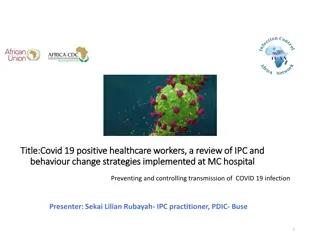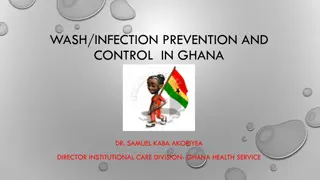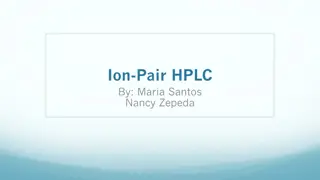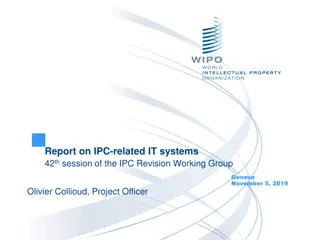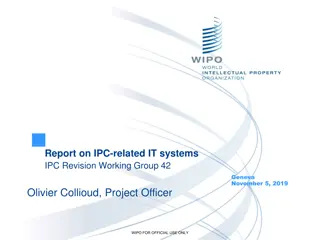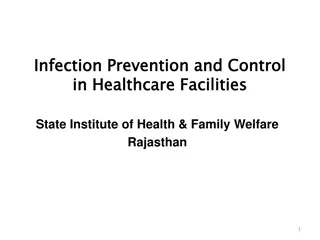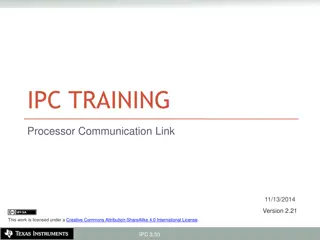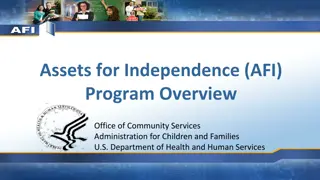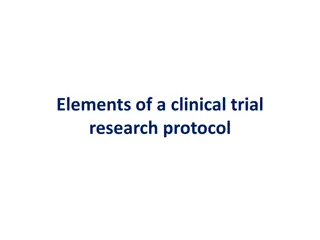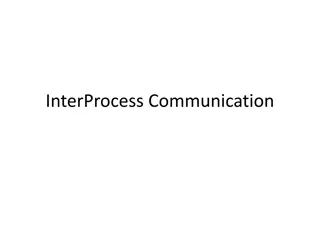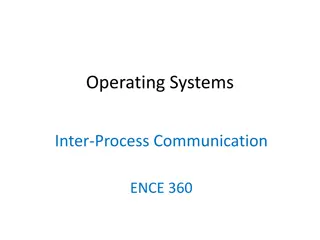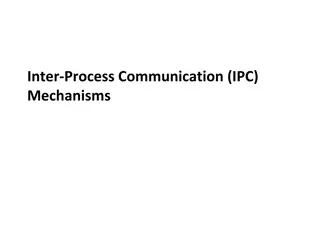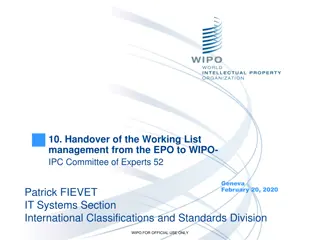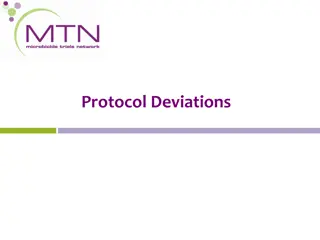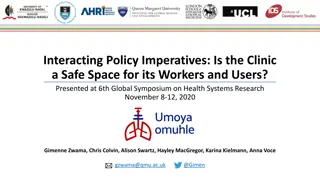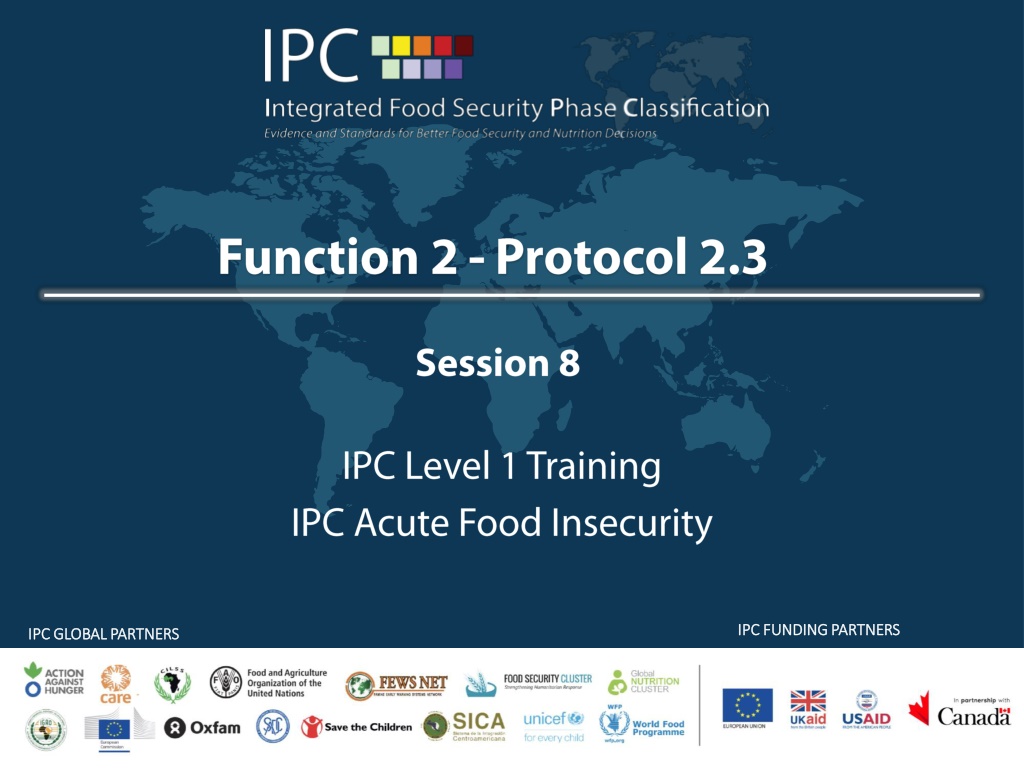
Analyzing IPC Protocol 2.3 for Food Insecurity Parameters
Explore the 13 analytical parameters outlined in Protocol 2.3 for analyzing food insecurity situations, including definitions, severity phases, evidence convergence, and humanitarian assistance considerations. Get ready to present and discuss these parameters for a comprehensive understanding of food insecurity analysis.
Download Presentation

Please find below an Image/Link to download the presentation.
The content on the website is provided AS IS for your information and personal use only. It may not be sold, licensed, or shared on other websites without obtaining consent from the author. Download presentation by click this link. If you encounter any issues during the download, it is possible that the publisher has removed the file from their server.
E N D
Presentation Transcript
IPC FUNDING PARTNERS IPC FUNDING PARTNERS IPC GLOBAL PARTNERS IPC GLOBAL PARTNERS
Protocol 2.3: Adhere to parameters for analysis What is the objective of Protocol 2.3? To set the rules for analysis so that analysts can follow parameters thus promoting global comparability, accountability and high quality of analysis. How does Protocol 2.3 work? It includes 13 Analytical Parameters, ranging from a) to m) For each analytical parameter, brief guidance is included providing the overview of its role in the analysis Special additional analytical parameters for Famine classifications and classifications of areas with limited or no humanitarian access are provided separately (may be covered in another session in this training if these situations are likely in the country this session focuses only on protocols applied in all conditions)
What are the thirteen analytical parameters? a) Definition of acute food insecurity and an analytical focus b) Informing action with short-term strategic objectives c) Five severity phases d) Convergence of evidence e) Twenty percent rule for area classification f) Unit(s) of analysis g) Snapshot in time with validity period h) Incorporating humanitarian assistance i) Current classifications j) Projection classifications k) Identification of areas that have received or will receive significant humanitarian food assistance l) Identification of key drivers and most affected populations m) Populations in need of urgent action
Thirteen Analytical Parameters The facilitator will assign a parameter to each pair. Then, in pairs... Exercise 8.1 - - Review the text in the IPC Technical Manual Version 3.1 (pages 40 to 43). Provide a three-minute presentation. [Parameter F, H, I, J and K) will be presented by the trainer] Be ready to answer difficult questions!
a) Definition of acute food insecurity and an analytical focus Acute Food Insecurity is defined for IPC as food deprivation that threatens lives or livelihoods, regardless of the causes, context or duration. IPC acute food insecurity classification identifies the need for urgent action to decrease food gaps and protect lives and livelihoods. Key points: Food consumption gaps and negative livelihood coping are both facets of food insecurity and can be present separately or together Regardless of cause: may be a factor of vulnerability, or of an endogenous or exogenous shock . Information on causes is important for decision-makers, but this analysis does not influence analysis of severity or classification of the food security situation Regardless of context: food insecurity may happen in any kind of context Regardless of duration: food insecurity can last for a long or for a short period
b) Informing action with short-term strategic objectives Informs actions that have measurable results within one year. Actions to mitigate short-term food insecurity should be linked to medium- and longer term objectives (identified by IPC Chronic Food Insecurity Classification) Key points: Strategic response objectives included in IPC Reference Tables for each Phase/Level Recommendations for Action a standard module in the Communication Template: Response priorities Situation monitoring activities Data collection and information system
c) Five severity phases Phases with different severity are used as the basis of all classifications Populations of households are to be distributed among the severity phases Key points: Phases 1 and 5 need to incorporate both HH and area phase names only one Reference Table that includes both area and HH outcomes as opposed to Manual Version 2.0
d) Convergence of evidence IPC brings together evidence on indicators directly measuring food security outcomes as well as contributing factors to estimate the proportion of households in each Phase. Key points: The whole body should be brought together for analysis - but only relevant evidence of a minimum reliability should be used for classification and estimation of populations; Evidence on malnutrition and mortality are only considered to the extent that they are driven by food gaps and to confirm or question food insecurity classification; In order to be considered, livelihood change outcome must be caused by negative changes in food security dimensions, esp. regarding access to food; It is important to provide a justification for the convergence of evidence conclusions reached by the analysts, referring to body of evidence used
d) Convergence of evidence (cont.) Key points (cont.): Evidence does not always converge especially because: Context matters Relevance as indicators measure different things Reliability, both in terms of methods and time relevance of evidence Non-converging evidence should be carefully assessed by considering these factors, and outliers may be given less importance For estimation of the populations it is advisable: To convergence evidence by consensus building and critical review of evidence supported by the Reference Table and Analytical Framework - not by average, modelling, or individual indicators. Not to use ranges for final population estimations althoughranges may be useful to support estimation of populations for outcomes. Use of rounding is advisable and percentages may be rounded to nearest 0 or 5% and populations for example to nearest thousand.
d) Convergence of evidence (example) Example table on food consumption indicators for Convergence of Evidence: Background Sindh/Pakistan suffers from severe drought that has caused a spike in food insecurity No convergence of indicators: data indicates a potential food gap through FCS and rCSI, but households still have at least some food to consume as HHS is low. It is likely that even if not all of the 40% of HHs have high food consumption gaps as expected in a Phase 4 situation and as FCS and rCSI indicate, it is probable that many of them do. Analysts do not follow one or another extreme value, but aim for the middle ground
e) 20% rule for area classification An area is classified in a specific IPC Phase when at least 20 percent of the population in the area are experiencing the conditions related to that Phase or more severe Phases Key points: Phase classification intrinsically linked to population estimates Recommended to cross-check final classification with Phase description to see if conditions on the ground match the identified Phase (and population estimates) Phase 1 Phase 2 Phase 3 Phase 4 Phase 5 Area Phase Examples 20% 30% 35% 15% 0% Phase 1 Phase 2 Phase 3 Phase 4 Phase 5 Area Phase 45% 40% 10% 5% 0%
f) Unit of analysis Two possible analysis units that can be used independently or together: area- based analysis and household analysis group based (HAG) analysis Key points: Area analysis: Whole area and the total population are analysed Total population is distributed across the severity Phases based on the co-existence of conditions Specific groups living in the area should still be analysed even if they are not classified separately Household Analysis Group (HAG) analysis: Analysis performed on one or several relatively homogeneous groups with regard to expected food security outcomes At a minimum the group(s) analysed must be at least 20% of total population for area classification purposes Detailed population tables can only be produced if 100% of the area population are analysed and classified
g) Snapshot in time with validity period Classification is a picture in time of acute food insecurity that is either currently happening or projected in the future within a given time frame. Key points: Each classification has a validity period during which the situation is not expected to change significantly If the situation changes the analysis should be updated, or a new analysis should be conducted Validity period depends also on seasonality aspects, decision-makers needs, expected data availability etc. Validity period can vary from a few weeks up to a year as long as the food security situation within that period is expected to remain relatively similar
g) Snapshot in time with validity period (cont.) For example For example If the coming food insecurity situation is If the coming food insecurity situation is expected to behave like this . expected to behave like this . Optimally we would have two projections Optimally we would have two projections More Severe Projected with Projected with Validity Period May Validity Period May to Jul to Jul Projected with Projected with Validity Period Aug Validity Period Aug to Oct to Oct Current with Validity Current with Validity Period from Jan to Apr Period from Jan to Apr Expected Severity of Acute Food Insecurity Reporting on Reporting on peak of lean peak of lean season season reporting reporting on peak of on peak of start of start of lean lean season season Less reporting on situation as reporting on situation as seen at time of analysis seen at time of analysis Severe May Dec Mar Nov Aug Sep Feb Apr Oct Jun Jan Jan Jul What we should not do is to have only one projection from May to Oct! What we should not do is to have only one projection from May to Oct!
h) Incorporating humanitarian assistance Current classification is a snapshot in time with any potential effects of humanitarian assistance. Projection classification includes any expected effects of likely humanitarian food assistance Key points: Population in Phase 3+ does not necessarily reflect the total population in need of assistance as some households may be in lower Phases due to receiving assistance and may be in need of continued action Humanitarian food assistance considered for projections should be regular or inter- annual, and any other assistance that is planned, funded or likely to be funded and delivered during the projection period Newly appealed for assistance is not considered in the projection analysis
i) Current classifications Current Classifications are based on actual conditions, regardless of causes, context and duration. Key points: Just as a thermometer measures the exact temperature felt at the moment it is dipped in hot water, IPC classifies exactly what it sees at that moment in time this being the product of all [mitigating and aggravating] factors Current population tables identify those currently found in different severity Phases An understanding of the potential role of humanitarian assistance in mitigating the severity of acute food insecurity is necessary
i) Current classifications (cont.) For example For example The following table should have a disclaimer The following table should have a disclaimer Current Number of People by Phase (regardless of potential provision of humanitarian assistance) Current population table refers to those currently found in different severity Phases.Thepopulation of 14,500 people in Phase 3 or more severe does not necessarily reflect the full population in need of urgent action to decrease food gaps and protect and save lives and livelihoods. This is because some households may be in Phases 1 or 2 but only because of receipt of assistance, and as a result they may be in need of continued action. IPC does not quantify the impact of assistance and as a result alternative population figures discounting the effects of assistance are not provided.
j) Projection classifications Projected classifications are based on the expected population likely to be in different severity Phases, incorporating the effects of any planned humanitarian food assistance Key points: Based on a good understanding of current and historical conditions and forecast based on a set of clear assumptions on the evolution of the conditions Consider aggravating and mitigating factors that may have already happened or are most likely to happen Identifies those most likely to experience food gaps or who may be able to meet minimum food needs but only by engaging in livelihood coping strategies Based on the most likely scenario, including any planned, funded or likely to be funded and delivered humanitarian food assistance Population in Phase 3 or more severe refers to those in need of urgent action (despite any potential assistance that is expected to be delivered) Projections can be updated when assumptions made earlier do not hold Updates can be done without direct evidence on outcomes and can only extend until the end of the existing validity period
j) Projection classifications (cont.) Start by Current Classification Relying on normal trends and assumptions for upcoming trends, infer expected outcome indicators whenever historical/baseline evidence is available (e.g. HEA, FCS, rCSI, GAM) Relying on the whole body of evidence, project severity of the situation Is the projection situation likely to be more severe, similar, or better than the current situation? Is the situation likely to change by a Phase, or are populations going to move between Phases without changing the classification? For example For example Current Phase in all areas is... Phase 3 Analysts conclude that situation will remain in Phase 3 in projection period, with more households facing Phase 3 and 4 conditions
j) Projection classifications (cont.) Remember to observe the 20% rule of classification Clearly label the table and add a disclaimer For example For example Projected Number of People in Need (from xxx to xxx 2019) Number Percentage Area Phase 1 20% Phase 2 25% Phase 3 50% Phase 4 5% Phase 1 Phase 2 Phase 3 Phase 4 Phase 5 Phase 5 Area 1 Area 2 Area 3 National Aggregates 0% 2 000,0 2 500,0 5 000,0 500,0 - 20% 60% 20% 0% 0% 2 000,0 6 000,0 2 000,0 - - 10% 20% 60% 10% 0% 1 000,0 2 000,0 6 000,0 1 000,0 - 30% 30% 30% 10% 0% 5 000,0 10 500,0 13 000,0 1 500,0 -
k) Identification of areas that received or will receive significant humanitarian food assistance Identification of areas should be done after the classification and should conclude whether the area received or is likely to receive significant humanitarian food assistance Key points: IPC protocols are not designed, nor should they be used, to formally assess the impact of any humanitarian assistance on food insecurity or to monitor achievements towards goals. By humanitarian food assistance IPC refers to direct resource transfers that have the objective to reduce food gaps and protect and save lives and livelihoods. Only transfers that have an immediate positive effect on household s access to food are to be considered. May include different modalities - e.g. distributions of food, cash or vouchers, and livelihood assets
l) Identification of key drivers and most affected populations IPC provides tools for basic analysis of key drivers and limiting factors as per the IPC Food Security Analytical Framework. The analysis is not, however, detailed and more analysis should be conducted for targeting purposes. Key points: Key drivers are typically the main factors affecting food security and can be found in the hazards and vulnerability section of the IPC Food Security Analytical Framework. Examples include weather related shocks, conflict or price shocks Limiting factors of food insecurity are analysed by identifying which combination of factors related to the availability, access, utilization and stability prevent people from being food secure By identifying key shocks and vulnerabilities affecting current conditions, analysts are also able to indicate likely key drivers of acute food insecurity and, to the extent possible, some characteristics of the most affected populations
m) Populations in need of urgent action IPC identifies populations with significant food deficits and/or with negative livelihood coping that need urgent action. These are populations classified in Phase 3 or above that require urgent action to decrease food gaps and to protect and save lives and livelihoods, with severity of the situation increasing in Phase 4 and subsequently in Phase 5. Key points: Population estimates take into consideration any mitigating impacts of any regular or ad-hoc assistance. Population in Phase 3+ does not necessarily reflect the full population in need because some households may be in Phase 2 or 1 but only because of receipt of assistance and may thus still be in need of continued action. The IPC Technical Manual Version 3.1 does not provide protocols to generate population estimates without the effects of humanitarian assistance which is necessary to estimate the total population in need of assistance.

